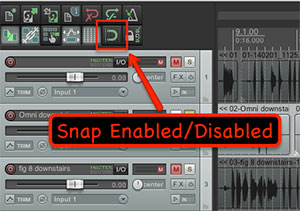 The Reaper blog just published a post about a setting I didn’t know about, and it really helps me a lot! It’s called the “Snap Relative to Grid” setting. In a lot of my tutorials, I warn people to pay attention to whether the Snap tool (looks like a magnet – see the pic on the left) is enabled or disabled. It’s incredibly useful when you want to snap the edges of your item to a gridline (which can be bars/beats, or minutes/seconds, etc.). But if you are trying to nudge something just a bit to the left or right on a track, having the Snap tool enabled will be trouble.
The Reaper blog just published a post about a setting I didn’t know about, and it really helps me a lot! It’s called the “Snap Relative to Grid” setting. In a lot of my tutorials, I warn people to pay attention to whether the Snap tool (looks like a magnet – see the pic on the left) is enabled or disabled. It’s incredibly useful when you want to snap the edges of your item to a gridline (which can be bars/beats, or minutes/seconds, etc.). But if you are trying to nudge something just a bit to the left or right on a track, having the Snap tool enabled will be trouble.
One problem I run into quite a bit is when I am dragging a bit of audio from one track to another. I don’t have a very steady hand (so you don’t want me doing brain surgery on you :)), so I almost always manage to slip the audio a bit left or right when I am just trying to drag it up or down. Of course, this will mess up the timing, and I often find myself undoing (“ctrl-z” is the best keyboard shortcut EVER) and trying again. Or I drag the edge of the audio item out beyond its actual start or stop time to get it to line up with a gridline, then turn on the Snap tool, then drag it up, then turn off the Snap tool. Craziness, I know! In my mind, I knew there was a way to keep the audio aligned in time while dragging to a different track, but I’m lazy, so I never looked it up.
Well, it turns out the answer is “Snap Relative to Grid.” You just go to the Snap/Grid settings (right-mouse click on the Snap tool) and put a check mark in the “Snap relative to Grid” box. That way, if the edges of your audio happen to fall between gridlines, and you want to drag the audio up to a different track, the edges will stay aligned with however far away the audio was from the nearest gridline to start with. In a nutshell, this means you can drag your audio clip up to a different track without worrying about it slipping left or right (earlier or later in time) in the process. In other words, it’s the right tool for the job I’ve been doing the hard way for years. Yay!
Here is Reaper’s blog post about it, along with an animation that shows you both how to select the option and what it does for your audio item when dragging it up or down to a different track. Hope this makes you as happy as it makes me :). http://reaperblog.net/2014/10/reaper-faq-what-does-snap-relative-to-grid-mean/
audio editing
Brand New Audio Gear at B&H – Shhhh!
This has not even been publicly announced yet, but as readers of Home Brew Audio, you and I get special pre-announcement notice. How cool is that?
So what are these new items?
Zynaptiq UNCHIRP Plug-in Electronic Download – (Codec Artifact Removal & Transient Retrieval)
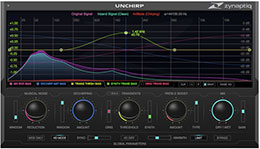 I can’t wait to try this! You know that weird swirly sound you sometimes get after running a noise-reduction effect on audio? If you’ve done much noise reduction/removal, then you’ll know exactly what I’m talking about. Other terms for this unpleasant side-effect of noise reduction are: “that under-water sound,” “warbling,” or “the tweeties.” Well this new product – now available to you before the general public (it’s August 28th, 2014 today) – suppresses those after-effect high-frequency sounds, as well as several other things like reducing musical noise, fix transient smearing, and restoring lost high frequencies, all of which can happen during “lossy” audio conversion that reduces sound quality to make it more convenient to stream on services like Spotify and Pandora. CLICK HERE for more information. And to purchase for download, CLICK HERE.
I can’t wait to try this! You know that weird swirly sound you sometimes get after running a noise-reduction effect on audio? If you’ve done much noise reduction/removal, then you’ll know exactly what I’m talking about. Other terms for this unpleasant side-effect of noise reduction are: “that under-water sound,” “warbling,” or “the tweeties.” Well this new product – now available to you before the general public (it’s August 28th, 2014 today) – suppresses those after-effect high-frequency sounds, as well as several other things like reducing musical noise, fix transient smearing, and restoring lost high frequencies, all of which can happen during “lossy” audio conversion that reduces sound quality to make it more convenient to stream on services like Spotify and Pandora. CLICK HERE for more information. And to purchase for download, CLICK HERE.
Zoom iQ6 Stereo X/Y Microphone for iOS Devices with Lightning Connector
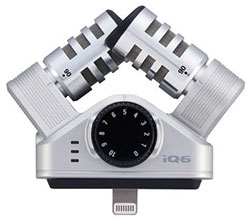 This is a stereo microphone that plugs into devices that have Lightning Connectors, namely iOS devices like the iPhone (5 and 5S) and iPad (anything newer than the iPad 2, such as the iPad Mini or the iPad 4th generation). These mics are the same ones used on the Zoom H4N handheld digital audio recorder.
This is a stereo microphone that plugs into devices that have Lightning Connectors, namely iOS devices like the iPhone (5 and 5S) and iPad (anything newer than the iPad 2, such as the iPad Mini or the iPad 4th generation). These mics are the same ones used on the Zoom H4N handheld digital audio recorder.
To get more details on how awesome it would be to turn your iPhone into a high quality stereo field recorder, and/or to get one of your own, CLICK HERE.
UPDATE: The Zoom iQ6 is available now!
Different Ways To DeEss A Vocal Recording
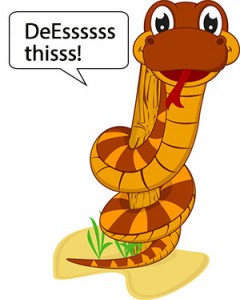 The term “deEss” or “de-ess” refers to editing an audio recording – usually of a voice – when the “S” (and sometimes “sh” and “th,” etc.) sounds (technically called “sibilance”) seem much too loud in relation to to rest of the vocal. It involves trying to reduce the volume or energy of JUST the S sound while leaving the rest of the vocal alone. There is a specific kind of audio editing tool for this, called a “DeEsser.” See my article How to Fix SSS-Sibilance in Your Audio With Sound Editing Software for the basics on sibilance and deEssers.
The term “deEss” or “de-ess” refers to editing an audio recording – usually of a voice – when the “S” (and sometimes “sh” and “th,” etc.) sounds (technically called “sibilance”) seem much too loud in relation to to rest of the vocal. It involves trying to reduce the volume or energy of JUST the S sound while leaving the rest of the vocal alone. There is a specific kind of audio editing tool for this, called a “DeEsser.” See my article How to Fix SSS-Sibilance in Your Audio With Sound Editing Software for the basics on sibilance and deEssers.
But there are other ways to tame those sibilant sounds. Below is a post from Audio Geek Zine with some ideas on several different ways to do it. This article is extra cool since it uses Reaper for the examples. Our course, The Newbies Guide To Audio Recording Awesomeness 2: Pro Recording With Reaper, shows you how to use Reaper to record and produce professional audio projects. I used Reaper in that course because that is my go-to recording software. The concepts taught, however, are certainly just as applicable to any other recording program.
Anyway, I digress. The article I mentioned about different ways to de-ess (deEss, whatever) a vocal is here:
http://audiogeekzine.com/2013/07/advanced-deessing-techniques/
The Snap Tool In Reaper: The Benefits And Possible Pitfalls
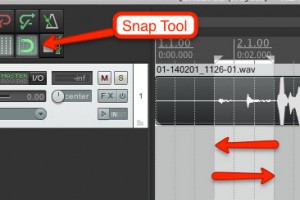 We have a video on YouTube showing how to use a built-in tool in Reaper (ReaFir) as an excellent noise removal tool (that video is here: Hidden Noise Reduction Tool in Reaper). Interestingly, we received a comment on that video today that said “Dude – I didn’t even come here for the snap and select thing but that helped me soooo much thank you.”
We have a video on YouTube showing how to use a built-in tool in Reaper (ReaFir) as an excellent noise removal tool (that video is here: Hidden Noise Reduction Tool in Reaper). Interestingly, we received a comment on that video today that said “Dude – I didn’t even come here for the snap and select thing but that helped me soooo much thank you.”
That got me thinking that if the commenter felt the snap tool comments in the video, which were just there to help the viewer more accurately select part of the audio containing ONLY noise, were that valuable, maybe we should dedicate a post to just that. So that’s what’s happening right now…even as you read this:).
Snaps and Grids
The reason for a Snap tool in software that uses grids – such as graphics programs, video and audio programs, etc. – is to enable a user to accurately place a cursor onto a grid line. You literally cannot place the cursor between two grid lines. Whichever grid line your cursor is closest to is the one that it will snap to. This can be a great help in lining up multiple media items. In audio programs like Reaper, it also allows you to select audio that starts and stops exactly on the grid lines, which – when set to “bars and beats” – makes it super easy to select exactly one measure of music (assuming that music was recorded to a click-track/metronome). That, in turn, allows you to cut or copy entire bars of music, paste them somewhere else in the song, and have them be musically correct.
Of course there are tons of other uses. One such is demonstrated in our video on how to copy/paste instead of “punching in” when you need to fix mistakes while recording. See that post and video here: Quickly Fix Audio Recording Mistakes by Overdubbing.
However, the downside of having the Snap tool enabled is that you give up some control. You may want (or NEED) to select audio whose edges are between grid lines. Or you may just want total control over where you put the cursor. But both of those things are impossible when snapping is enabled. Wouldn’t it be great if you could toggle snapping on and off whenever you wanted? Well you can in Reaper. It’s in the default tool panel – a button that looks like a magnet. See the picture at the top left. Also, of course, there is the video below that shows you how to use it about half-way through.
Filter The Mourning Dove Hoot Out Of The Voiceover Recording
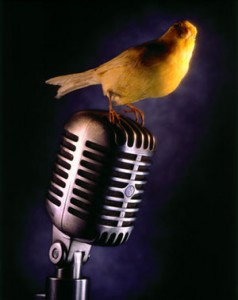 I was working on a long voiceover recording job last week. After it was all recorded, I began the long process of editing it for the client. That involved not only optimizing the volume and minimizing the noise, but also creating 27 separate files. Things were progressing nicely, but then I heard an odd sound behind the voice at one point. You can probably guess by the title of the post what that sound was. Sigh.
I was working on a long voiceover recording job last week. After it was all recorded, I began the long process of editing it for the client. That involved not only optimizing the volume and minimizing the noise, but also creating 27 separate files. Things were progressing nicely, but then I heard an odd sound behind the voice at one point. You can probably guess by the title of the post what that sound was. Sigh.
Keep in mind that most voiceover jobs do not involve multitrack recording. That is to say, there is only one single track of audio being recorded. So if you hear a bird’s hoot AND your voice together on the recording, you can’t just “delete” the bird sound. In multitrack recording – such as you would use for most music recording – you purposely put different sounds on their own tracks so you can adjust the volume of each sound until it all mixes together nicely. THEN you render (mix down) the result to a single file. But I did not have the luxury of simply turning down the bird hoot. How in the world do I get rid of it?
OK, sure. I could just re-record that part when the bird is NOT outside my window. But that smacks of effort. I like to do things the easy way if I can. Yes, you may substitute the word “lazy” into that last sentence:-P. Anyway, there are some audio editing tools that you can use to reduce (or even eliminate) one type of sound, while leaving the desired audio alone. One of the best of these tools is EQ (short for “equalization”).
If the undesired audio has a much different frequency than the desired audio, then EQ can help filter out what you don’t want to hear. Sadly, this is not always the case. Sometimes, in order to remove one sound, you end up removing some or most of the sound you want to keep. But in this case, I was in luck.
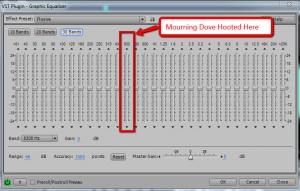
One other piece of good fortune was that a small amount of the dove noise was sounding during a section when the voice was not talking. It wasn’t enough to sample into a noise-reduction effect (unfortunately – because that is another good way to filter out the bad while leaving the good). So I highlighted the small bit of audio that had ONLY the mourning dove hoot in it. Then I opened the Graphic Equalizer tool in Adobe Audition (I still use version 3, but Audition is also part of Adobe CC – Adobe Audition CC [Digital Membership]). While listening to the hooting on a loop, I just started dragging down sliders (each slider is set to a specific frequency). If it didn’t silence the bird, I reset the sliders and tried the next one. It only took me about 10 seconds to locate the right frequency, which happened to be 500 Hz.
Awesome. Now that I knew that this particular mourning dove hooted at 500 Hz, I went back to the audio with both the voice AND the bird hooting in it, and highlighted that section. Then I just opened the Graphic Equalizer and started moving the slider at 500 Hz down, which turns down the volume at just that frequency. Now voices also produce sound at 500 Hz, so it I turned things down too much, the voice would also be affected. But in this case, by the time I moved the slider down enough to get rid of the dove, the voice still sounded fine. It probably helped that it was a female voice.
And the bird was gone! the entire process took about 60 seconds, which is a lot less time than it would have taken me to re-record the voice.
So the next time you have a bird outside your window threatening to ruin your recording session, remember this method. It might save you time and money. Of course, you could always build you own vocal isolation booth to record in. But that’s another topic altogether.